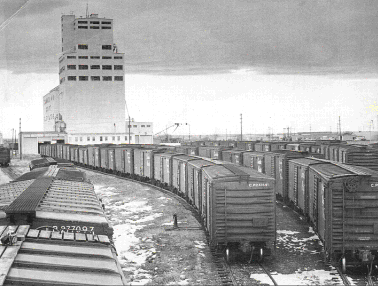
One of the most common landmarks that can found across the prairies is the grain elevator. In contrast to the flat prairie landscape that surrounds them, these buildings tower over 100 feet high, and have a rather unique construction that distinguishes them from any other type of building. Grain elevators have indeed become a unique, yet required feature for agricultural farming.
The development of the grain elevator can be linked to the past, when early settlements were usually located no more than ten miles apart along the rail line. This distance was governed by the necessity to make it easier for farmers to transport their agricultural products by wagon. Thus, grain elevators were strategically located in many of these settlements to act as gathering points for storing and transporting grain products for farmers in the surrounding area. Although modern farmers can now transport their grain further with trucks than they could by wagon, elevators remain dispersed throughout the prairie landscape.

P19760234060-GP Rail cars wait to be filled with wheat in front of the Alberta Government grain terminal in Lethbridge.
The modern grain elevator is a tool that allows for the loading and unloading of grain in a minimally labor intensive way. The operation begins as a farmer drives a fully loaded grain truck on to a scale where it is weighed. The grain is then dumped into a pit or hopper that is built into the ground, and the farmer’s truck is again weighed to determine the weight of the load of grain. At this point the grain is inspected and given a rating or grade which determines its quality and potential price. The grain is then carried up from the pit or hopper in small cups attached to a conveyor called “the leg” which ascends to the top of the elevator. As the grain reaches the top of the leg it is distributed to a specified interior bin for storage. In some cases, where a large storage capacity is required, the grain is distributed to exterior bins or silos. In either case, the grain is always stored in bins that contain the same type or grade of grain. Once the elevator bins become full and a destination for the grain has been determined, trains are brought in to be loaded up. By means of a mechanical auger, the rail cars are then easily loaded and transported to market for distribution or processing.
The technology and ingenuity that grain elevators represent are a perfect example of the hard work and time that early farmers put in to settle the prairies. And although still used as a tool for transporting grain to market, the grain elevator also serves as an emblem of prairie agriculture even in modern times. One is reminded upon seeing these buildings that they represent not only prairie agriculture, but a combination of technology, and transportation that has linked the prairies not only to the rest of Canada, but to the rest of the world.
Previous Page | Exhibit Contents | Home | Navigation Information | Glossary | Curriculum Guide | Next Page
Copyright © 1996 Sir Alexander Galt Museum. All rights reserved.